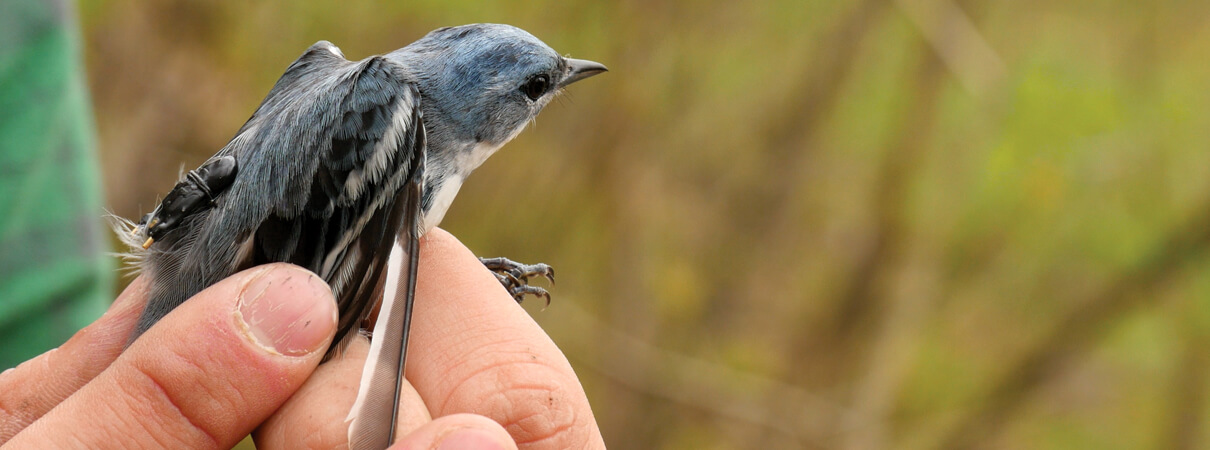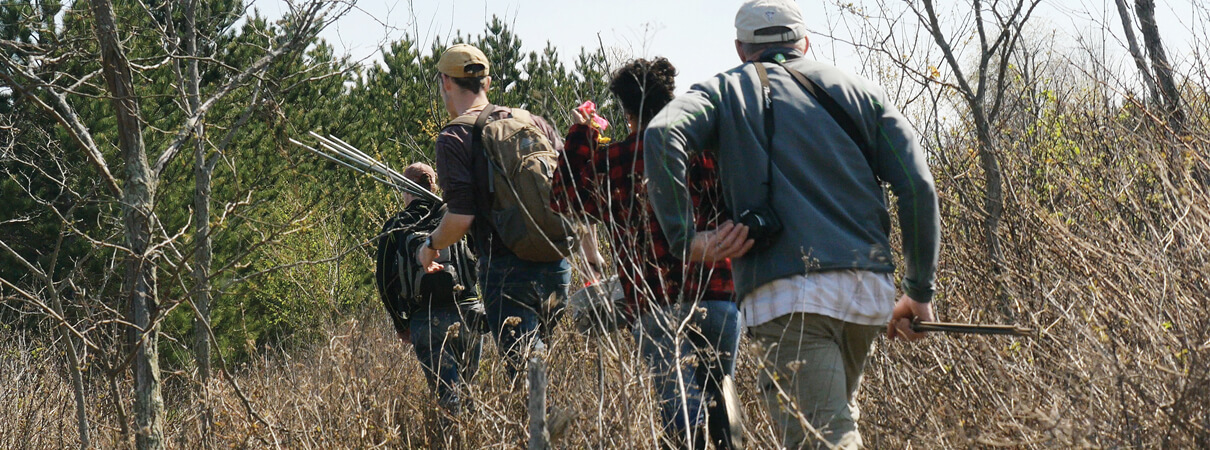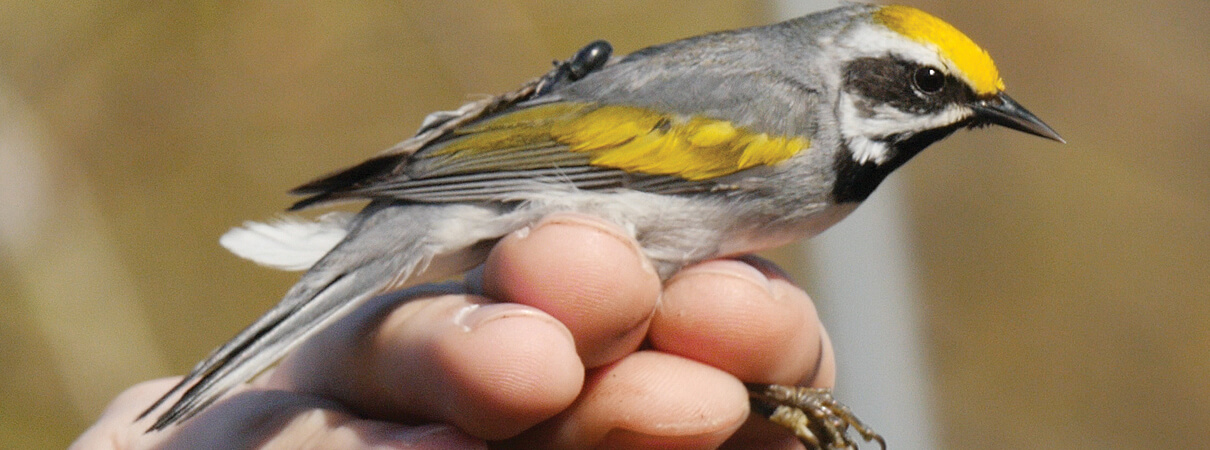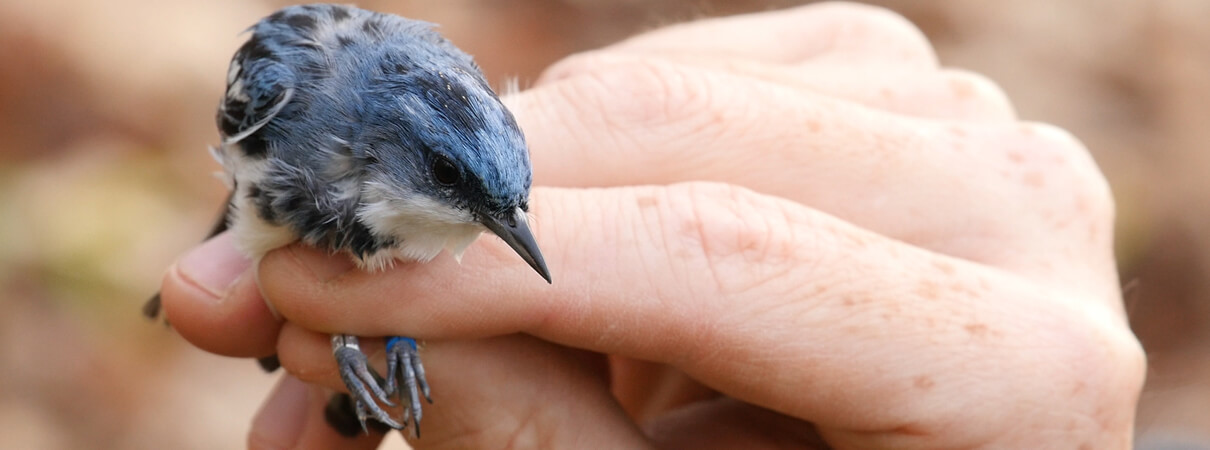Warblers Help Unlock the Secrets of Migration
His breath visible in the early-morning spring air, Doug Raybuck ticks off the names of furtive forest residents with ease: Chestnut-sided Warbler. Scarlet Tanager. American Redstart.
Distinct birdsongs surround him, suggesting the whereabouts of warblers and other migratory birds just recently arrived from Latin America.

The small backpack-like device on this Cerulean Warbler's back contains a light-sensitive geolocator that allows scientists to determine where the bird travels during migration. Photo by Aditi Desai
He pauses and listens. A faint “zee zee zee zizizizi eeet” whispers through the trees in this corner of Pennsylvania's Allegheny National Forest. Binoculars raised to the sky, Raybuck searches for the source.
To untrained eyes, the slight movement of birds flitting between tree branches could be mistaken for leaves rustling in the breeze. Thick forest cover and deep shadows hide the birds' bold plumage. But Raybuck knows what to look and listen for. With ears tuned to nature's podcast—the spring edition—he spies his guy.
The bird he calls Elmer is back. And Raybuck plans to catch him.
First, Scientists Must Catch a Warbler
Named after the elm tree in which researchers found him nesting, Elmer is a Cerulean Warbler. He weighs less than two nickels, and yet this small songbird flies thousands of miles from his winter home in Latin America to his summer residence in northwestern Pennsylvania. He makes this epic journey twice every year, in the spring and in the fall.
Until now, Elmer's migratory route and winter destination had been a mystery. Only sporadic data and observations connected the dots. But technology is finally catching up with nature. Soon Elmer and others like him will help unlock the secrets of migration.
In May 2015, Raybuck and researchers from Arkansas State University and Indiana University of Pennsylvania (IUP) attached tiny tracking devices called geolocators to Elmer and 18 other Cerulean Warblers in the area. Weighing less than half a gram, they harnessed the geolocator to Elmer's body like a miniature backpack housing a personal warbler-sized computer. The device records light data that helps researchers map Elmer's journey across states, countries, and oceans.
Warblers tend to come back to the same nesting sites year after year, giving researchers an opportunity to relocate the birds and recover the devices. Now, a year later, Raybuck and Morgan Slevin, both graduate students in biology at Arkansas State, are on a mission to recover that device and the precious data it contains.
Having spotted their bird, Raybuck and Slevin spring into action. Tackle box—check. Net—check. Portable speakers—check. The two researchers roll down their sleeves in deference to the chilly temperatures and get to work.

Doug Raybuck, a graduate student in biology at Arkansas State University, puts up a mist net to recapture Cerulean Warblers returning to their nesting habitat in Pennsylvania's Allegheny National Forest. Photo by Aditi Desai
Raybuck embeds a telescoping pole into the moist forest ground. Slevin sets up another pole about 20 feet away and quickly attaches a mist net between the two. They hope this structure, not unlike a volleyball net, will catch Elmer. Now all the scientists need to do is lure him in.
Cerulean Warblers are territorial. They defend their nesting sites from other trespassing ceruleans with fierce determination. Raybuck and Slevin are banking on these defensive characteristics to draw the bird closer. Raybuck places speakers on both sides of the net to play the song of a Cerulean Warbler. By tricking Elmer into thinking another Cerulean is intruding on his turf, the biologists hope the bird will come after the supposed intruder and fly into the net—and into their waiting hands.
Why Does the Migration of Warblers Matter?
Catching a warbler takes skill, time, and money. Why go to such lengths to figure out where a bird travels? Jeff Larkin, a professor of wildlife ecology and conservation at IUP, has a simple answer: conservation.
“If we're going to bring back the birds, we need to know what those birds really need,” says Larkin, who also serves as ABC's Eastern Forest Habitat Coordinator. “Where do they go? How do breeding and wintering populations connect? Where are important migratory stopover areas?” After synthesizing these research findings, Larkin says he and his team can then provide ABC's on-the-ground partners with management guidelines or conservation recommendations that will help the birds most.
Cerulean Warblers are more selective than many other bird species. Not just any type of forest will do: To woo mates, nest, and raise their young, these birds need mature trees with openings in the canopy cover nearby. The housing market can be competitive as they jockey with other birds for prime nesting real estate.
Meanwhile, they also confront habitat loss and poor forest management, which limit their options even further. Along with threats during migration—including storms, collisions with glass and communication towers, and attacks from free-roaming cats—these birds have a tenuous existence. In the past 40 years, the Cerulean Warbler's population has declined by 70 percent, making it one of North America's most threatened migratory songbirds.
Larkin and Than Boves, an assistant professor of ecology at Arkansas State, are principal investigators of the study. They work closely with Raybuck and other researchers to collect data that, in the long-term, will inform critical conservation decisions.
Knowing where a bird is in the summer isn't enough, though. Migratory songbirds such as Cerulean Warblers need protection in all of their different homes: north, south, and in between. Data makes it possible for conservation actions to be more strategic. Technology and a small army of dedicated scientists, in fact, may be the best hope these tiny birds have to survive and thrive.
“We could create the best habitat in the world here, they could love it here, they could thrive here,” Larkin says of the Pennsylvania breeding grounds. But if they suffer during migration or experience declines on their wintering grounds, he says, “then ultimately, what we do up here is for naught.”
Studying the Golden-winged Warbler
The Golden-winged Warbler is also choosy about finding just the right nesting habitat. And like the Cerulean Warbler, the Golden-winged Warbler has also suffered a steep population decline in recent decades. It's another priority species that will benefit from close examination of its flight patterns and needs.
Just as with the Cerulean Warbler, understanding the data from geolocators will be crucial to the golden-wing's survival. On a crisp spring morning, Larkin, three graduate students, and a field technician head into The Wilds in central Pennsylvania. Poles over their shoulders and a tackle box in hand, from a distance they could easily be mistaken for a group of friends gone fishing.

Jeff Larkin and crew head into young forest in search of Golden-winged Warblers. Photo by Aditi Desai
The researchers head into scrubby, young forest dense with patches of prickly shrubs. Like a gentler version of barbed wire, the shrubs cut through them, leaving behind scratches and bits of clothing. Glaring sun and wind also make their jobs difficult. (Searching for warblers, it turns out, is quite different from fishing.)
One of the graduate students, Cameron Fiss, stops to listen. “Bee-bz-bz.” The unmistakable sound of a Golden-winged Warbler. Encouraged, the team checks out the area—this spot might work, this one won't, not enough trees, too much sunlight—until they find a spot that will do.

A Golden-winged Warbler wearing a geolocator. Photo by Aditi Desai
The bird is trickier to catch than expected. Sun and wind make the mist net conspicuous, and the wary golden-wing isn't falling for the recorded birdsong used by the researchers. After trying multiple times, the team decides to move the location of the net. Within minutes, the bird swoops in.
“Go get him!” Larkin shouts. Fiss runs to the net and gently extracts the warbler. Together he and the team gently snip off the geolocator and place it in a bag. That tiny device contains hope for the species. Geolocators recovered from Golden-winged Warblers are sent to the lead investigators from the University of Toledo and University of Minnesota who extract and analyze the data.
After recording the bird's weight and a few other measurements, Darin James McNeil Jr., another graduate student, lets him go.
“Good work, little buddy,” he says softly.

Graduate student Darin James McNeil Jr. releases a Golden-winged Warbler after removing its geolocator. Photo by Aditi Desai
Unlocking the Mystery, One Warbler at a Time
Back in Allegheny National Forest, Raybuck and Slevin hide near trees on opposite ends of their mist net and play the call of the Cerulean Warbler. In an instant, Elmer moves down from the treetops to protect his patch of forest. Darting in to attack the pretend intruder, Elmer flies right into the net.
Like the Golden-winged Warbler team, Raybuck and Slevin remove the geolocator and measure and weigh Elmer. With the device safely in hand, Slevin releases the tiny bird. “I'm sure he feels a little bit lighter now,” Raybuck says. Holding the key to your species' future must be a heavy burden.

Elmer the Cerulean Warbler is held gently after being recaptured in a mist net. The geolocator on his back will be removed, and the data it contains will help biologists better understand the conservation needs of Cerulean Warblers and other migratory songbirds. Photo by Aditi Desai
Elmer's geolocator will soon reveal his journey. But first, Raybuck needs to interpret the data. Connecting the geolocator to his computer, Raybuck runs the raw data of dates, times, and light levels through a software program. Based on daily sunrise and sunset times calculated from the light data, Raybuck can connect the dots and estimate where Elmer went using approximate locations.
This diminutive songbird took an epic trip. From his winter home in northeast Colombia, Elmer took off on March 20. His first stop: Costa Rica and Nicaragua, for a brief two-week respite. Around April 5, he visited Guatemala for three weeks before flying nonstop across the Gulf of Mexico.
After resting and refueling in central Tennessee for a week, Elmer set off on the final leg of his journey. On May 3, the tiny songbird flew from Tennessee back to his elm tree in Pennsylvania—and into the waiting hands of scientists ready to map his migration and chart a brighter future for his species.
Click here to watch a video about scientists' efforts to understand migration.
With your support, we can better protect the places that migratory birds like Elmer need. Click here to donate.
Funding for these research efforts was provided by the Pennsylvania Game Commission, USDA Natural Resources Conservation Service, U.S. Fish and Wildlife Service, U.S. Geological Survey, and National Science Foundation.
Editor's note: This article first appeared in the fall 2016 edition of Bird Conservation magazine.
 Aditi Desai is ABC's Assistant Director of Communications and Senior Producer. She spent six days this spring with Jeff Larkin and other biologists braving the wilds of Pennsylvania to learn about warblers, migration, and advancing science through the use of technology. She also got to hold her first Golden-winged Warbler.
Aditi Desai is ABC's Assistant Director of Communications and Senior Producer. She spent six days this spring with Jeff Larkin and other biologists braving the wilds of Pennsylvania to learn about warblers, migration, and advancing science through the use of technology. She also got to hold her first Golden-winged Warbler.


















































